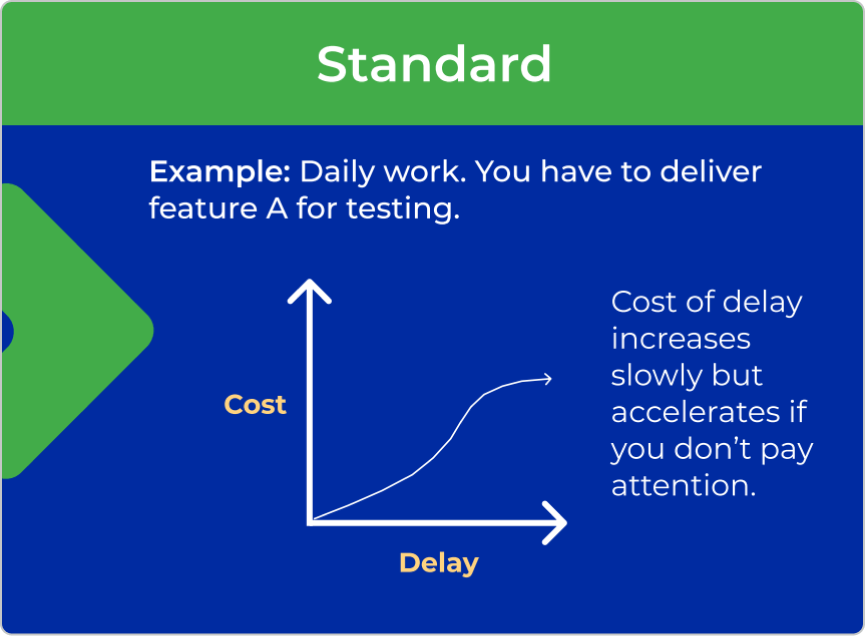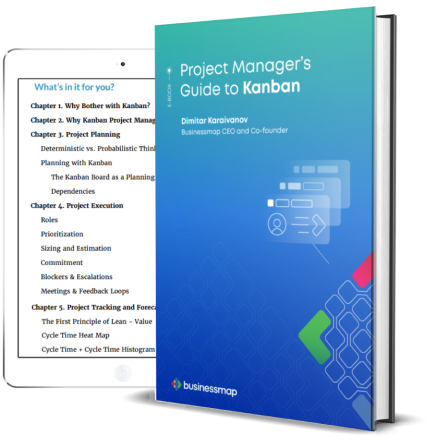When managing projects, you may encounter unexpected changes like new customer requirements or stakeholder requests. These can make it difficult to deliver successfully. It's important to prioritize work and reduce risk, which is where kanban's classes of service approach can help.
In this article, we’ll focus on kanban classes of service, the most prominent types, and the benefits they can bring to any working system. We’ll also explore examples of this highly configurable and versatile way of coping with uncertain and unpredictable situations.
What Are Kanban Classes of Service (CoS)?
Kanban classes of service are a set of policies or guidelines used in Kanban to categorize work items based on their priority and risk level. This helps Agile teams to prioritize and manage their workflow more efficiently by ensuring that high-priority work is given more attention and that risks are appropriately mitigated.
What Is the Role of Cost of Delay?
The cost of delay plays a critical role in managing kanban classes of service as it helps teams to prioritize work items based on their potential impact on delivery. By considering the cost of delay, teams determine which work items are most valuable and ensure that they receive the necessary attention and resources.
What Are the 4 Types of Kanban Classes of Service?
Generally, Kanban defines 4 classes of services for risk management:
- Expedite
- Fixed Date
- Standard
- Intangible

Let’s dig into the four widely recognized archetypes of Kanban classes of service.
Type 1: Expedite
Expedite is the highest Kanban class of service. It is reserved for work items/projects with a critical priority and a very high cost of delay. When something is qualified as an Expedite CoS, it requires 100% devotion from your team.
Work items in this class come with a huge risk for your project. To deal with them, you must leave everything else in progress and allocate all the necessary capacity to deliver them within the service level agreement.
This includes exceeding the configured WIP limit, as emergency tasks should exit the workflow rapidly. It is a good practice to set a WIP limit of 1 to this CoS to keep the focus on a single task only. However, this limit can be increased if the number of tasks entering the flow as an emergency goes up.

Type 2: Fixed Delivery Date
The second most important kanban class of service is dedicated to assignments with a fixed date and a high cost of failing to deliver on time. One example of such an item would be preparing an MVP (minimum viable product) by June 6 that comes with a clause that allows your customer to pay a lower price if you fail to do so. Another example is the one illustrated in the image below.

Projects that qualify for this class require detailed forecasting and careful consideration before committing. Implementing techniques such as Monte Carlo simulations can be invaluable in the process of negotiating the delivery date. They allow you to run many random simulations based on previous performance to give you probable delivery time frames to minimize the risk of failing to deliver on time.
Type 3: Standard
Most tasks in your workflow should qualify as standard. This class of service is reserved for items with a moderate cost of delay, which tolerate long lead time and don’t require much prioritizing. We advise you to process them “first-in-first-out” when pulling them in progress.

Please note that when the cost of delay for your projects or tasks is homogeneous, relying solely on a Standard class of service is preferred. This is because classes of service usually serve the most important class pretty well, but that’s not true for the least important things.
As a result, some of the low CoS items can take a long time to complete due to higher CoS items' priority overrides. When some of the items take 2 days, but others take 200 days, the probability distribution will be much wider and harm the forecast.
Type 4: Intangible
Work items from this class of service can be considered as “chores”. You know you have to complete them, but there’s no rush to process them right away. Such assignments come with little to no cost of delay and allow very long lead times.
When prioritizing work, intangible tasks must come last. They are the place from which you are most likely to relocate capacity if an Expedite task arrives. Still, it should be noted that if an intangible item remains unprocessed for too long, it may create the environment for generating Expedite class assignments.

What Are the Custom Classes of Service?
The four kanban classes of service discussed so far can serve as a guideline, but you are free to define your very own according to risk. For example, in a software development context, it is common to define a 5th class called Bugs, usually placed between the Fixed delivery date and Standard CoS.
Another viable option not limited to IT is proposed by the Lean coach Thorbjørn Sigberg. It is called Urgent, and it is suitable for teams that struggle with decomposing and decoupling work. It allows them to give higher priority to unplanned assignments without expediting them.
He suggests using this CoS for small requests like changing a text on a webpage that would otherwise “drown” in the Standard class. Once again, it should be placed between the Standard and the Fixed delivery date classes.
Still, these are just examples. You can customize classes of service in any way to fit into your context.
How to Manage Risk with Kanban Classes of Service?
In a Kanban system, a class of service typically determines the priority of a work item or a project (depending on the scale of implementation) and how quickly it will flow across your board. Choosing to introduce kanban Classes of service allows Agile teams to define service level expectations and establish agreements for each class of service they provide.
This way, they can manage risk by:
- Improving the predictability of lead time for high-risk items
- Making the process of managing dependencies less difficult
Improving the Predictability of Delivery
Lead time is the time frame between a customer requesting a service/product and the moment it is delivered. Another essential metric here is “value-adding time”, or the time your team spends actively working on delivering that service/product. The ratio between value-adding time and the lead time is your flow efficiency (one of the most important Lean Management metrics). Most companies have very low efficiency. You might be surprised to hear that the commonly reported ratio is between one to five percent at the start. This means more than 90 percent of the time required to deliver a project is wasted waiting for something. This greatly increases the risk of delay.
Most companies have very low efficiency. You might be surprised to hear that the commonly reported ratio is between one to five percent at the start. This means more than 90 percent of the time required to deliver a project is wasted waiting for something. This greatly increases the risk of delay.
By defining Kanban Classes of Service, Agile teams give certain work items or projects more priority than others. In turn, this reduces the waiting times in the workflow for the high-priority items and makes their final delivery more predictable.
For example, think of how airlines treat passengers depending on the type of ticket they’ve bought. The more expensive ticket you purchase, the higher the class of service you get. This comes with various benefits like quicker boarding, more spacious seats, better food, etc.
In this case, each passenger is a work item for the airline. The path from requested to done goes through multiple stages like checking in, onboarding, traveling, etc. When some passengers are qualified for a higher class of service, they spend less time waiting to move through the process and enjoy a better service.
Therefore, the lead time required for them to receive the final deliverable is significantly reduced, and the quality is better than those with the lowest class of service tickets.
Simplifying the Process of Managing Dependencies
Кanban classes of service allow you to manage dependencies according to the cost of delay (CoD) for each project. CoD is the economic impact of failing to deliver your product or service on time or, simply said – the amount of money you will lose by delaying the delivery. By calculating CoD, you can understand the importance of delivering your projects on time.
The logic is simple. When the cost of delay is small, or there’s enough time to start early, there’s no need to manage dependencies explicitly. You can just let them emerge and manage them dynamically.
However, when the CoD is high, you need to plan your capacity in a way that will allow you to start early and complete the project with greater efficiency, even if it results in delaying other projects with lower costs of delay.
10 Years Kanban Experience In 1 Free Book.
Project Manager's Guide to Kanban
What Are the Benefits of Using Kanban Classes of Service?
The benefits of using Kanban classes of service include:
-
Prioritizing work items: By assigning work items to different classes of service, teams can prioritize their work and focus on the most critical tasks first.
-
Managing risk: Kanban classes of service help teams manage risk by ensuring that high-priority work items are given the necessary attention and resources.
-
Improving workflow efficiency: By streamlining their workflow and ensuring that work items are appropriately prioritized, teams can work more efficiently and effectively.
-
Better communication and collaboration: Kanban classes of service can help improve communication and collaboration among team members by providing a shared understanding of work item priorities and urgency.
-
Flexibility: Kanban classes of service are flexible and adaptable, allowing teams to adjust their workflow and priorities as needed to respond to changing project requirements or business needs.
-
Better data analysis: Having work items based on a class of service allows teams to analyze data and make data-driven decisions separately for each type by using various Kanban metrics.
What Are Some Best Practices for Using Kanban Classes of Service on a Kanban Board?
Implementing classes of service requires some additional configurations on your kanban board. Depending on your Kanban software functionalities, it may offer a few options to visualize classes of service.
In Businessmap, for example, the most widely used way to prioritize and improve work organization is by using swimlanes. Kanban swimlanes provide you with a horizontal color-coded division of your board. Using them to set each class of service will ensure that you have a complete visualization of your work, making it easy to track work progress and notice any weak spots.
 Prioritizing Tasks with Kanban Swimlanes
Prioritizing Tasks with Kanban Swimlanes
The Software Development team in Sensata's Mechanization department introduced kanban classes of service to help the team align its work priorities with them. They used swimlanes for each class of service, such as one for incidents and another for standard support work, to differentiate and manage risks distinctly. As a result, they achieved a certain level of predictability for urgent and fixed-date requests.
Another successful use case of implementing classes of service is the scenario at Encoparts. They defined different classes of service in the customer service area using Businessmap swimlanes to visualize the difficulty level of the service: "Hard," "Medium," and "Easy." As an improvement, they achieved better prioritization in customer service by gaining focus and efficiency in their service, which sped up the handling of more complex orders.
Another common scenario is using different workflows for each class of service. Examples of classes of service where multiple workflows are particularly useful are “Expedite” and “Standard”. The idea here is that “Standard” tasks go through the established project process flow, while expedited cards pass through a simpler process with fewer steps.
Businessmap is the most flexible software
to align work with company goals
In Summary
Kanban classes of service allow you to minimize risk by improving the predictability of your workflow and managing dependencies easier. Practically, they are sets of policies that guide you and your team when prioritizing new work.
Kanban defines 4 classes of service, but you are free to customize them and add new ones according to your needs.
- Expedite - for assignments with the highest cost of delay that don't tolerate the accumulation of lead time
- Fixed delivery date - for assignments with a fixed delivery date that have a high cost of delay
- Standard - for the majority of assignments with low to medium cost of delay that tolerate longer lead times
- Intangible - for assignments with low cost of delay










 Most companies have very low efficiency. You might be surprised to hear that the commonly reported ratio is between one to five percent at the start. This means more than 90 percent of the time required to deliver a project is wasted waiting for something. This greatly increases the risk of delay.
Most companies have very low efficiency. You might be surprised to hear that the commonly reported ratio is between one to five percent at the start. This means more than 90 percent of the time required to deliver a project is wasted waiting for something. This greatly increases the risk of delay.
 Prioritizing Tasks with Kanban Swimlanes
Prioritizing Tasks with Kanban Swimlanes 


